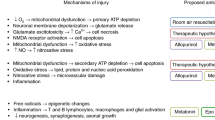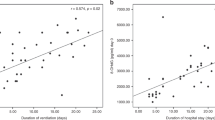Abstract
Objective
To evaluate the effect of high dose phenobarbital on lipid peroxidation and antioxidant enzymes in perinatal asphyxia.
Design
Open label, Randomized controlled trial.
Setting
Neonatal intensive care unit of a tertiary care teaching hospital.
Participants
72 full term inborn neonates with severe birth asphyxia.
Methods
Neonates were randomized to Study (phenobarbital) group and Control group. The infants in the study group received phenobarbital infusion (40mg/kg) within first two hours of life while babies in the control group did not receive any phenobarbital. Rest of the management in both the groups was as per the unit protocol for the management of hypoxic ischemic encephalopathy. A cerebrospinal fluid examination was done at 12 ± 2 hours of life to determine the levels of superoxide dismutase, glutathione peroxidise and malonyldialdehyde. 60 neonates were followed up at 1 month of age when a detailed neurological examination was done.
Results
Four neonates in the study group and six neonates in the control group died during the study. Two neonates in the study group were lost to follow up. The cerebrospinal fluid lipid peroxides and antioxidant enzymes were significantly lower in the phenobarbital group as compared to the control group. The neurological outcome at one month follow up was found to be comparable between the two groups.
Conclusion
Phenobarbital (40mg/kg) given in the first two hours of life in term neonates with perinatal asphyxia led to a decrease in CSF levels of lipid peroxides and antioxidant enzymes at 12 ± 2 hours of life.
Similar content being viewed by others
References
Volpe JJ. Hypoxic ischemic encephalopathy: biochemical and physiological aspect. In: Neurology of the Newborn, 3rd ed. Philadelphia WB Saunders. 1995.p.217–259.
Biogas K. Hypoxic ischemic brain injury: advancement in the understanding of mechanisms and potential avenues for therapy. Curr Opin Pediatr. 1999;11:223–231.
Vanucci RC, Perlman JM. Interventions for perinatal hypoxic ischemic encephalopathy: relation to perinatal brain damage. Pediatr Res.1990;27:317.
Fritz KI, Ashraf QM, Zubrow AB, Mishra OP, Papadopoulous MD. Expression and phosphorylation of N-methyl d-aspartate receptor subunits during graded hypoxia in cerebral cortex of newborn piglets. Biol Neonate. 2004;85:128–137.
Saugstad OD. Mechanism of tissue injury by oxygen radicals: implications for neonatal disease. Acta Pediatr. 1996;84:1–4.
Goldberg RN, Moscoso P, Bauer CR, Bloom FL, Curless RG, Burki B. Use of barbiturate therapy in severe perinatal asphyxia. J Pediatr. 1986;109:851–856.
Baughman LV, Hoffman W, Miltovich J, Albrecht RF. Effects of phenobarbital on cerebral blood flow and metabolism in young and aged rats. Anaesthesiology. 1986;65:500–505.
Vanucci RC, JM Perlman. Interventions for perinatal hypoxic ischemic encephalopathy. Pediatrics. 1997;100:1004.
Bewge JA, Aust SD. The thiobarbiturate assay. Methods in Enzymology. 1978;52:306.
Hopkins J, Tudhope G. Glutathione peroxidise in human red cells in health and disease. Br J Haematol. 1973;25:563–567.
Misra HP, Fridovich I. The role of superoxide anion in the autooxidation of epinephrine and a simple assay for superoxide dismutase. J Biol Chem. 1972;247:3170–3175.
Sarnat HB, Sarnat MS. Neonatal encephalopathy following fetal distress: A clinical and electroencephalographic study. Arch Neurol. 1976;33:696.
Singh D, Narang A, Kumar P, Majumdar S. Effect of phenobarbital on free radicals in neonates with hypoxic ischemic encephalopathy. J Perinatal Med. 2004;32:278–281.
Singh D, Kumar P, Narang A. A randomized controlled trial of phenobarbital in neonates with hypoxic ischemic encephalopathy. J Matern Fetal Neonatal Med. 2005;18:391–395.
Hall RT, Hall FK, Daily DL. High dose phenobarbital therapy in term newborn infants with severe perinatal asphyxia: a randomized prospective study with three year follow up. J Pediatr. 1998;132:345–348.
Svenningsen NW, Blennow G, Lindroth M, Gaddlin PO, Ahlstorm H. Brain oriented intensive care treatment in severe neonatal asphyxia. Arch Dis Child. 1982;57:176–183.
Evans DJ, Levene MI, Tsakmakis M. Anticonvulsants for preventing mortality and morbidity in full term neonates with perinatal asphyxia. Cochrane Database Syst Rev. 2007:3:CD001240.
Author information
Authors and Affiliations
Corresponding author
Rights and permissions
About this article
Cite this article
Gathwala, G., Marwah, A., Gahlaut, V. et al. Effect of high-dose phenobarbital on oxidative stress in perinatal asphyxia: An open label randomized controlled trial . Indian Pediatr 48, 613–617 (2011). https://doi.org/10.1007/s13312-011-0106-x
Received:
Revised:
Accepted:
Published:
Issue Date:
DOI: https://doi.org/10.1007/s13312-011-0106-x




